There is an all-new gallery experience in the lobby at the Opera House on Main Street, U.S.A. called "Evolution of a Dream,” celebrating 70 years of Disneyland’s history. This exhibit showcases some never-before-seen artwork and artifacts highlighting early Disneyland merchandise, the groundbreaking history of Audio-Animatronics® technology, and a tribute to Cast Members who brought Walt's dream to life over the past seven decades. In a special collaboration, The Walt Disney Family Museum loaned more than 30 artifacts, including awards that highlight Walt’s varied career and original furniture from Walt’s private apartment—on view at Disneyland for the first time.
Learn more about the "Walt Disney – A Magical Life" attraction at Disneyland by clicking here.
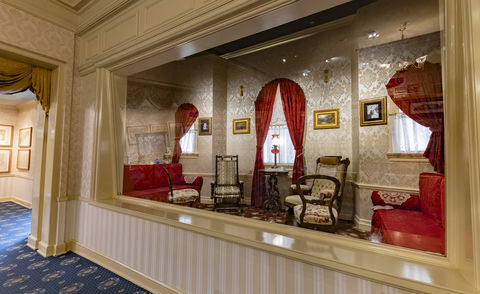
Apartment Furniture
Walt had an apartment built above the Fire Station on Main Street, U.S.A. where he could work and have a place for him and his family to stay. Academy Award®-winning set decorator, Emilie Kuri, was selected to furnish and style Walt’s apartment in a Victorian theme to match the era of Main Street, U.S.A. The furnishings and decor of the apartment were heavily inspired by Lillian Disney’s collection of cranberry glass.
In the early 1980s, the Disney family reclaimed the original furniture and most of the decorations that furnished the apartment. Now, a selection of original furniture and decor is on display in a breathtaking recreation of Walt’s apartment.
The teams at Disneyland and The Walt Disney Family Museum worked together to create faithful facsimiles of decorations and furniture items to give Guests a picture-perfect view inside the apartment where Walt resided when he visited Disneyland.
- Satin Rocking Chair
- Green Velvet Upholstered Rocking Chair with armrest and headrest doilies
- Two Wood Back Chair with Quilted Seats
- Tilt-Top Table with Floral Embroidery
- Red Frosted Etched Glass Electrified Kerosene Lamp
Awards
Through Walt’s many awards, Guests can discover the diverse qualities that shaped the man behind the brand. By experiencing the exhibit “Evolution of a Dream” and the new attraction “Walt Disney – A Magical Life,” visitors of all ages will gain a deeper understanding of who Walt Disney truly was—a dreamer who embodied the American spirit, persevered through setbacks, and ultimately earned the admiration and recognition of the public during his lifetime.
Conservation Awards
A selection of awards highlighting Walt’s many achievements and humanitarian efforts were selected to accompany the apartment display. In the 1950s, Walt was concerned with the vanishing frontiers around the world. He recognized the importance of inspiring young generations to not only understand but preserve the natural world and the creatures sharing our planet. Through his filmmaking, he championed conservation work with powerful storytelling in his True-Life Adventures nature documentary series, earning eight Academy Awards® along the way.
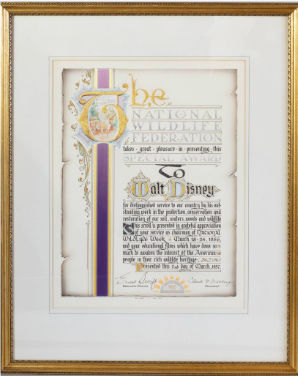
National Wildlife Federation, The National Wildlife Federation Special award, 1957
During National Wildlife Week in 1957, the National Wildlife Federation (NWF) awarded Walt with a special award for his “distinguished service to our country by his outstanding work in the protection, conservation, and restoration of our soil, waters, woods, and wildlife.”
Walt would go on to serve as the honorary chairman of the National Wildlife Federation for 11 years. He created public service announcements that helped to support and promote National Wildlife Week. In his 1957 public service announcement, he called upon viewers: “Won’t you do your part and protect your very good neighbors—the wildlife that is around you?”
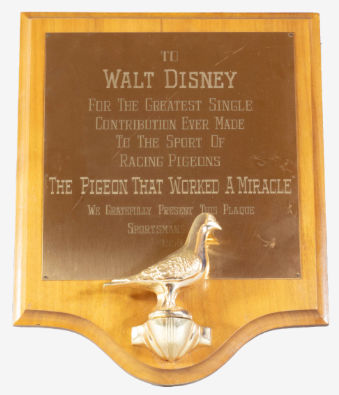
Racing Pigeon Association, For the Greatest Contribution Ever Made to the Sport of Racing Pigeons, The Pigeon that Worked a Miracle Award, 1958
Walt took an interest in the sport of pigeon racing and decided to produce a segment about it on his weekly television show, the then-titled Walt Disney Presents. The episode, “The Pigeon That Worked a Miracle,” was a light adaptation of the book Pigeon Fly Home by Thomas Liggett.
In the episode, Chad—a twelve-year-old boy—sustained an injury during a baseball game and was confined to a wheelchair. The doctors are convinced that his paralysis is psychosomatic and triggered by fear because Chad is too afraid to attempt to walk again. During this time, he picks up a new hobby of raising and training pigeons. When his favorite pigeon, Pidge, is in peril, the desire to save Pidge gives Chad the determination and strength to get out of his wheelchair and walk again.
In the episode, The Santa Barbara-Ventura Racing Pigeon Combine was called upon to provide the pigeons needed and to organize the pigeon release for the climactic race.
After the episode was released, The Nation Pigeon Association presented Walt Disney with the James R. Laimore Award. This award is presented to the person who, in the opinion of the committee, has done the most service to pigeons that year. Engraved on the plaque it reads:
“To Walt Disney for the Greatest Single Contribution Ever Made to the Sport of Racing Pigeons
‘The Pigeon That Worked a Miracle’"
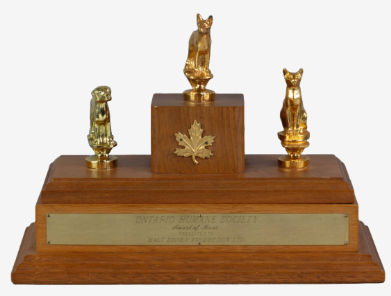
Ontario Humane Society Award of Merit, 1963
In 1963, the Ontario Humane Society presented Walt Disney Productions with their Award of Merit for Disney’s live-action film The Incredible Journey (1963) that takes place in Ontario, Canada. The three animal co-stars—Luath the yellow Labrador, Bodger the English Bull Terrier, and Tao the Siamese cat—are represented on the award adorning the top with two dog statuettes and one cat statuette, respectively. The Ontario Humane Society provides various services related to animal welfare, including sheltering, adopting, and offering humane education.
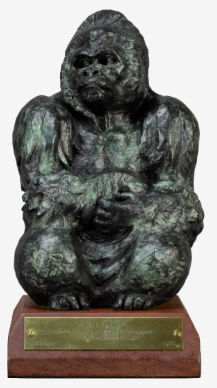
San Diego Zoological Society, Contributions to Worldwide Support of Conservation Award, 1966
This eye-catching award—an artistic sculpted gorilla cast in metal—was awarded to Walt in 1966 from the San Diego Zoological Society, today known as the San Diego Zoo. In celebration of the Zoo’s 50th anniversary, they recognized Walt’s contributions to the worldwide support of conservation.
In 1956, Walt shared, “You’ve probably heard people talk about conservation. Well, conservation isn’t just the business of a few people. It’s a matter that concerns all of us. It’s a science whose principles are written in the oldest code in the world, the laws of nature. The natural resources of our vast continent are not inexhaustible. But if we will use our riches wisely, if we will protect our wildlife and preserve our lakes and streams, these things will last us for generations to come.”
Academic Awards
Walt attended just one year of high school before leaving formal education behind in 1918 to serve in the American Red Cross to aid France in the aftermath of World War I. He pieced together a practical education through his own life experiences, using the world as his classroom. Walt’s later global success caught the attention of several prestigious universities—Harvard University, Yale University, University of Southern California (USC), and University of California, Los Angeles (UCLA)—who chose to honor him with honorary degrees.
In awarding Walt these prestigious honorary degrees, these universities recognized that the world had a lot to learn from Walt and his creativity. While Walt did not himself partake in higher education, he had a love for learning and wanted to share his endless curiosities with the public. When he gained the resources, he put his animators through an animation training program at the Chouinard Art Institute. In 1961, after being a longtime supporter of Chouinard, Walt and his brother Roy formed California Institute of the Arts (CalArts) by merging Chouinard Art Institute and the Los Angeles Conservatory of Music. “CalArts is the principal thing I hope to leave when I move on to greener pastures,” Walt shared. “If I can help provide a place to develop the talent of the future, I think I will have accomplished something.”
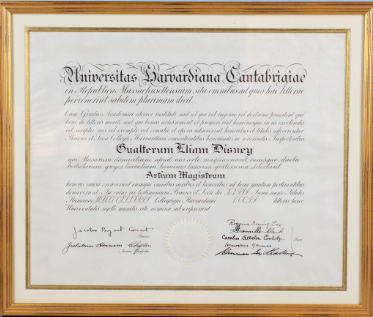
Harvard University, Honorary Master of Arts Degree from Harvard University, 1938
At the 1938 graduation ceremony Walt was honored with an honorary Master of Arts degree from Harvard. In the dedication speech, Harvard’s president shared, “Walt Disney is a magician who has created a modern dwelling for the Muses...”
During Walt’s acceptance speech he shared with the graduation class, "I'll always wish I'd had the chance to go through college in the regular way and earn a plain Bachelor of Arts like the thousands of kids nobody ever heard of who are [graduating] today."
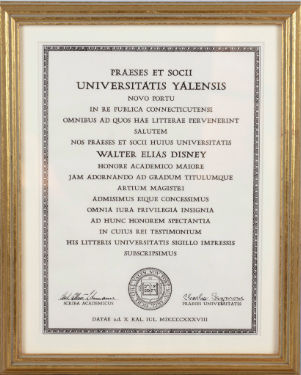
Yale University, Honorary Master of Art Degree from Yale University, 1938
In bestowing this honorary degree to Walt in 1938, Yale declared Walt to be the "creator of a new language of art" who had "the originality characteristic of genius." As for Walt, shortly before receiving the honorary degree, he said, "I'm a very uneducated man, a graduate of the school of hard knocks. I went as far as high school and art school in Chicago, but that was all."
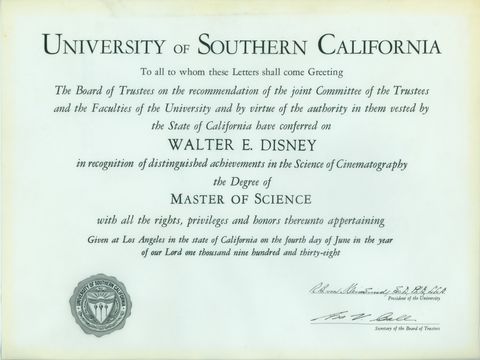
University of Southern California, Honorary Master of Science Degree from University of Southern California, 1938
Even though Walt never went to college, he was a proud supporter of the University of Southern California. In 1934, he was a founding member of the Trojaneers Booster Club—a group composed of men who did not go to college, but gave jobs to those who did. Walt regularly attended football games at USC and became the president of the Trojaneers in 1939.
In 1938, USC presented Walt with a Master of Science degree. USC’s president spoke of Walt’s achievement in “bringing to youngsters the spirit of innocent childhood and bringing to oldsters a bit of their second childhood.”
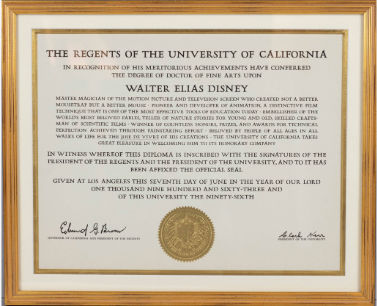
Regents of the University of California, Los Angeles; Honorary Doctor of Fine Arts from the University of California, Los Angeles; 1963
In 1963, Walt was presented a Doctor of Fine Arts from the Regents of the University of California (UCLA) as a “pioneer and developer of animation, a distinctive film technique that is one of the most effective tools of education today.”
Patriotic Awards
Walt’s love for America has always been reflected in Main Street, U.S.A.’s Opera House. In 1965, “Great Moments with Mr. Lincoln” debuted here as part of Disneyland’s Tencennial celebration—introduced with complimentary admission. Each ticket read, “So young people may have a better knowledge of the man who played such an important part in American history.” 60 years after “Great Moments with Mr. Lincoln” opened, many of the awards on display in the “Evolution of a Dream” exhibit recognize Walt’s own lasting contributions to the United States.
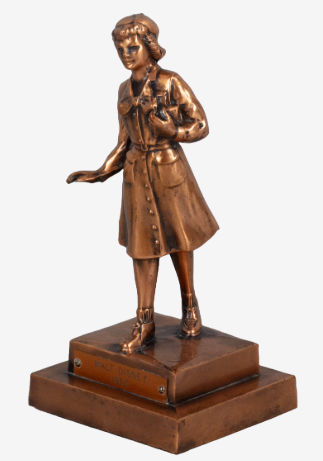
Girl Scouts of the United States of America Award, 1955
Founded in 1912 and chartered by the United States Congress in 1950, the Girl Scouts of the United States of America is the world’s preeminent organization dedicated solely to girls where, in an accepting and nurturing environment, they can build character and skills for success in the real world, including leadership, strong values, social conscience, and conviction about their own potential and self-worth. The Girl Scouts honored Walt with this award in 1955.
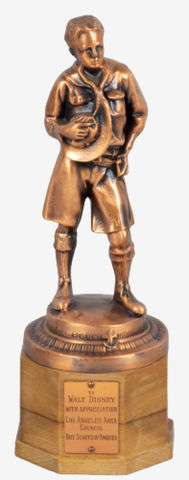
Boy Scouts of America, Boy Scouts Award of Appreciation, 1955
Founded in 1910 and chartered by the United States Congress in 1916, the Boy Scouts of America—now known as Scouting America—prepares young people to make ethical and moral choices over their lifetimes by instilling in them values including loyalty, kindness, and bravery.
Walt had been a Boy Scout in 1914 when his family lived in Kansas City, Missouri. He joined a Boy Scout troop from Sunday school classes in the Congregational church that the Disney family attended. He was at the Tenderfoot rank when he left the Boy Scouts due to his family moving back to Chicago, IL.
In 1946, the Boy Scouts awarded Walt with their highest honor, the Silver Buffalo Award. In 1955, they honored him again with this award.
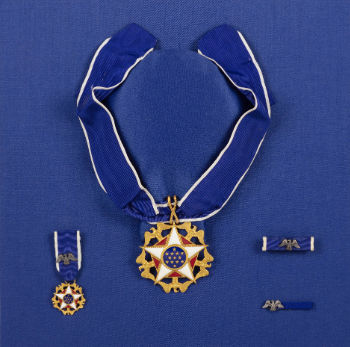
Presidential Medal of Freedom, 1964
In September 1964, Walt Disney was presented with the Presidential Medal of Freedom by President Lyndon B. Johnson at a ceremony in the East Room of the White House. Walt was described as: “Artist and impresario, in the course of entertaining an age, he has created an American folklore.” Walt was one of 30 recipients to receive this high distinction. At the ceremony featuring Walt and the other recipients, the New York Times reported that President Johnson said the group’s achievements “have made freedom stronger for all [of] us.” A list of recipients ranged from Nobel Prize winning-author John Steinbeck; Hellen Keller, leader in assisting the blind and deaf; abstract impressionist painter Willem de Kooning, and Pulitzer Prize®-winning poet and biographer Carl Sandburg.
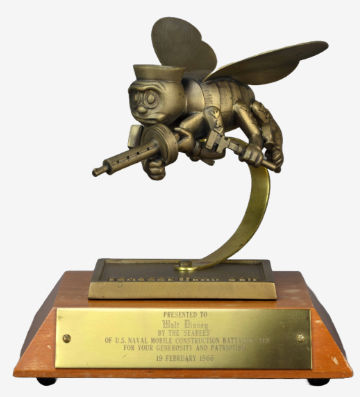
Seabees, US Naval Mobile Construction statuette, 1966
The day after Pearl Harbor was attacked in 1941, The Walt Disney Studio lots in Burbank were requisitioned by the US Army to house troops assigned to protect a nearby Lockheed aircraft plant. Walt—no longer young enough to enlist—was recruited by the government to create wartime-themed media. The Walt Disney Studios dedicated more than 90% of its wartime output to creating training, propaganda, and entertainment films, in addition to publicity campaigns and more than 1,200 military insignias.
One of the insignias created was for the Seabees, which derived from “CB,” the initials of the Construction Battalion. The Seabees organization was created during World War II by civilian construction workers and, in 1966, honored Walt for his generosity and patriotism with an award featuring the Disney-designed insignia mascot.
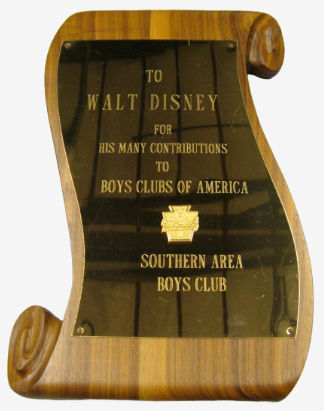
Boys Club of America, Southern Area plaque, 1968
In 1968, the Boys Club of America, Southern Area—known today as the Watts-Willowbrook Boys & Girls Club—presented this posthumous award to Walt for his many contributions to the Boys Club of America.
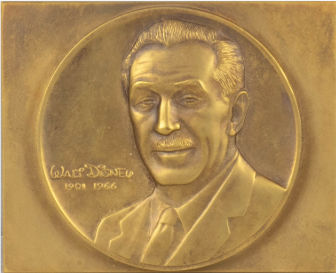
President of the United States of America, The Walt Disney Commemorative Gold Medal, 1969
On March 25, 1969, Walt was honored posthumously with the Walt Disney Commemorative Medal at the White House in Washington, D.C. President Richard M. Nixon presented the medal to Walt’s wife, Lillian Disney. The President shared, “On behalf of the Congress of the United States, by reason of a joint resolution, and on behalf of all the people of the United States and, I think, of the world, a gold medal; a gold medal honoring Walt Disney for his service through so many years not only to the people of the United States, but to the people of the world."
The gold medal was sculpted by prominent Walt Disney Imagineering sculptor Blaine Gibson and struck by the US Mint in Philadelphia, Pennsylvania. Congress authorized the US Mint to create 6,000 bronze replicas of the medal to sell as a fundraising effort to honor one of Walt’s last projects, the California Institute of the Arts. Now on display at Disneyland is the original gold medal presented to Lillian Disney.
Film Awards
A number of awards that celebrate films and television shows produced by The Walt Disney Studios were selected to highlight Walt’s vast and varied career.
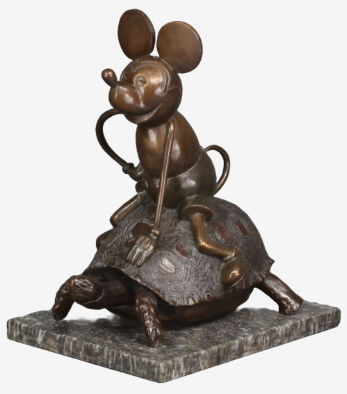
Artists of Brazil, Comandango Mickey Award, 1935
This uniquely styled award of Mickey Mouse riding a tortoise titled “Comandango Mickey” was gifted to Walt in 1935 from the artists of Brazil.
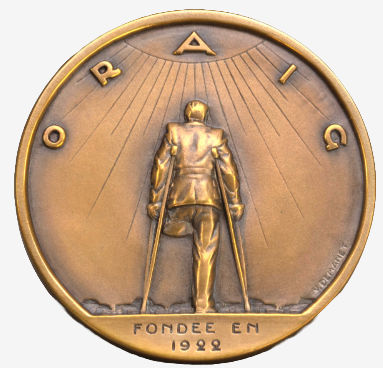
Committee for the Literacy and Artistic Advancement of the Cinema, League of Nations Medal, Outstanding Contribution to the Happiness of Children Throughout the World, 1935
In 1935, Walt received the League of Nations Medal from the Committee for the Literacy and Artistic Advancement of the Cinema, based in France. It was presented to him for his outstanding contribution to the happiness of children throughout the world by the creation of Mickey Mouse and the Silly Symphony cartoons. In a letter to the editor of Holiday magazine 20 years after receiving this honor, Walt recollected the memorable circumstances of its presentation: “My brother, Roy, and I were in London (this was 1935) prior to going to Paris to receive a medal from the League of Nations for Mickey Mouse. Under much protest, being strictly the sports clothes-type myself, we were persuaded to have morning suits made. We were told that any other attire would be inappropriate since it was to be an important occasion with ambassadors and other dignitaries in attendance. The fitting itself was a panic, with Roy's coat on me and mine on him, my pants on Roy and someone else's pants on me. The place was in a turmoil. Anyway, we went to the affair in Paris properly attired only to find that everyone there had wanted the boys from Hollywood to feel at home so they came in casual clothes! I haven't had the thing on since!"
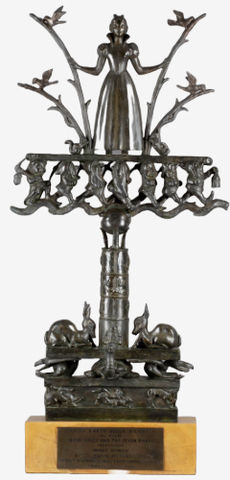
7th Biennial International Festival of Motion Picture Art, Trofeo D’Arte Della Biennale Award, 1938
An award that combines both uniqueness and importance is the Trofeo D’Arte Della Biennale Award or the Grand Art Trophy from the 1938 Venice Film Festival. This specially designed award—a bronze tree-like sculpture of Snow White, the seven Dwarfs, and forest animals—was presented to Walt to honor Snow White and the Seven Dwarfs (1937). On July 17, 1939, Walt wrote to the founder of the Venice Film Festival, Count Giuseppe Volpi di Misurata, thanking him for the award and praising its design: “The beauty and craftsmanship of this bronze trophy truly typifies the artistic abilities of the Italian people... Artistically, it surpasses anything we have in our collection of awards.” This special award was given a place of pride in Walt’s office at The Walt Disney Studios in Burbank.
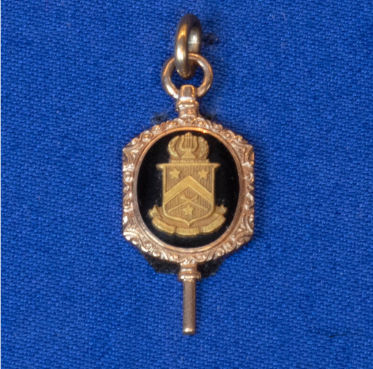
Delta Omicron International Music Fraternity, Award for Fantasia, 1940
Founded in 1909 at the Cincinnati Conservatory of Music, Delta Omicron International Music Fraternity is a professional fraternity in the field of music with collegiate chapters established throughout the United States and abroad. This award was presented to Walt Disney for his masterful combination of animation and classical music in the ambitious concert feature film Fantasia (1940).

Southern California Motion Picture Council, Appreciation of Creative Genius, 1952
A non-profit organization founded in 1936, the Southern California Motion Picture Council encourages production of family-oriented films, and television programs; promotes civic-minded, educational, and cultural programs of exceptional merit; and presents awards for the best in movies, television, stage plays, and the performing arts. Other honorees have included Bette Davis and Lucille Ball.

Hollywood Foreign Correspondents, Cecil B. DeMille Award, 1953
Founded in 1943 by a correspondent for the British Daily Mail newspaper, the Hollywood Foreign Press Association (HFPA) is comprised of journalists who cover the United States film industry and are affiliated with publications outside of North America.
The Cecil B. DeMille Award for lifetime achievement in motion pictures was named in honor of Cecil B. DeMille (1881–1959), one of the industry's most successful filmmakers. The HFPA created the Cecil B. DeMille Award in 1952 to recognize “outstanding contributions to the entertainment field.” The award’s first recipient was DeMille himself. Walt was honored with the second ever Cecil B. DeMille Award at the 1953 Golden Globe Awards. After receiving the award, Walt wrote to DeMille sharing, “I felt a deep sense of gratitude in receiving the DeMille Award... it was indeed an event that touched me.” [Walt Disney to Cecil B. DeMille, April 2, 1953]

Commemoration Cinderella Contest Award, 1953
A replica of the iconic glass slipper from Walt Disney's classic animated feature Cinderella (1950), this silver slipper commemorates the Cinderella Contest held in conjunction with the 1953 release of the film in Japan. Cinderella contests had been held in the United States for the film's original 1950 release, with publicity stating that the winner "must have character, personality, charm. It is not just beauty. It can be a cheerful disposition, a friendly helpful nature, or a particular talent for making others happy."
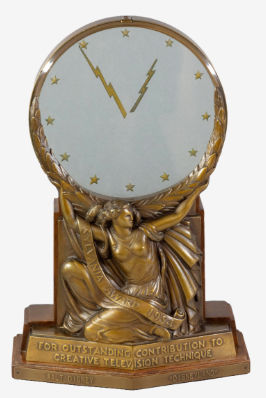
Sylvania Electric Products Company, Sylvania Award, Outstanding Contribution to Creative Television Technique, 1954
The Sylvania Award was issued from 1952 through 1958 by the Sylvania Electric Products Company—a manufacturer of television sets—for outstanding work in television broadcasting or production. Other Sylvania Award recipients include Rod Serling, Steve Allen, and Fred Rogers. This award for Creative Television Technique affirmed Walt's imaginative use of the television medium with his weekly television series. "We won't throw any piece of junk at the public," Walt pledged. "We fight for quality."
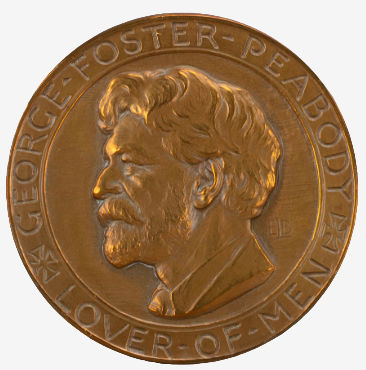
George Foster Peabody Award, 1955
Since 1941, electronic media’s most prestigious award, the Peabody Award®, is presented at the University of Georgia. The award recognizes achievements and meritorious public service by television and radio stations, networks, producing organizations, and individuals. In 1955, Walt was awarded the Peabody Award for his Disneyland television series, which in their words included “Mr. Disney’s delightful fantasies, his well-told tales, and his excursions into the world of the future.” Walt was awarded another Peabody in 1963.
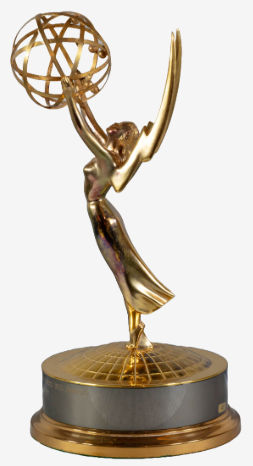
Academy of Television Arts and Sciences®, 8th Emmy® Awards, Best Producer, Disneyland, 1955
First presented in 1949 by the Academy of Television Arts and Sciences®, the Emmy Award® honors excellence within various areas of the television industry. This Emmy was awarded to Walt in 1956 as Best Producer for a Film Series for the Disneyland television show. In the previous year, Walt took home two Emmys for Disneyland as Best Variety Series and the Best Single Program of the Year ("Operation Undersea"). Overall, Walt Disney and the Disneyland television series won four Emmys.
Walt Disney was inducted into the Television Academy Hall of Fame in 1986.
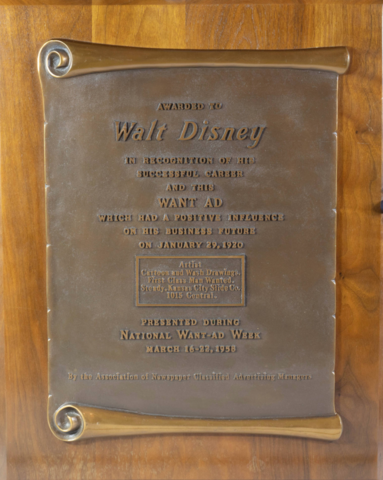
Association of Newspaper Classified Advertising Managers, 1958
This award from the Association of Newspaper Classified Advertising Managers commemorates the capability of a simple want ad to start a successful career—as he did with the fateful Kansas City Star want ad that Walt answered in 1920.
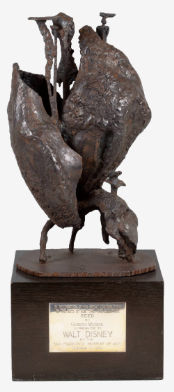
Gurdon Woods, San Francisco Museum of Art, Seed Award, 1958
In 1958, the San Francisco Museum of Art—known today as SFMOMA—presented Walt Disney with this bronze sculpture titled "Seed" in recognition of his "contribution to the arts of our time." If you are unsure what the award’s design is depicting, you are not alone, Walt did not know upon receiving it either. Disney animator Ken Anderson remembered Walt remarking the statuette looked like a burnt turkey on a pedestal with its legs sticking up in the air. The artist, Gordon Woods, was at the presentation of the award and came up to Walt. "It does look like a burnt turkey," he acknowledged. "What it is supposed to be is that your work and everything you do is like a seed you plant. That's supposed to be a seed sprouting." Walt replied, "I understand what this burnt turkey is now and will be proud to take it back with me to the Studio."
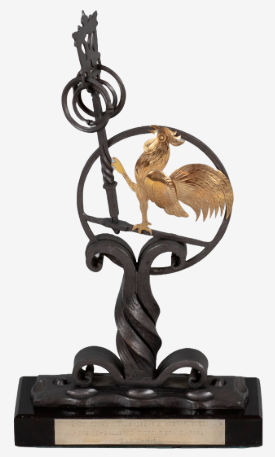
Concorso Internationale del Film per Ragazzi, Galletto d’Oro Fiera di Forlì, 1961
This Galletto d’Oro (Golden Cockerel) was presented to Walt at the 11th Annual Children’s Film Festival of Forlì for the first and only True-Life Fantasy of Walt’s True-Life Adventures series, Perri (1957)—released in Italy as Perry, presumably to make the title character’s name look more American.
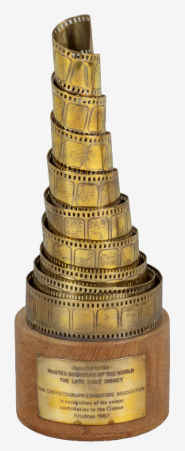
Cinematograph Exhibitors’ Association, “Master Showman of the World” award, 1967
The Cinema Exhibitors’ Association—known today as the UK Cinema Association—posthumously awarded Walt with the Cinematograph Exhibitors’ Association (CEA) award. Walt’s older brother Roy O. Disney flew to the United Kingdom to accept the award that proclaimed Walt as the “Master Showman of the World.”
